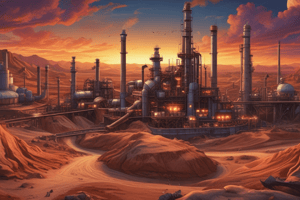Podcast
Questions and Answers
What type of plants are primarily responsible for the formation of coal?
What type of plants are primarily responsible for the formation of coal?
- Tundra plants
- Swamp plants (correct)
- Desert plants
- Marine plants
What is the primary use of petroleum in the transportation sector?
What is the primary use of petroleum in the transportation sector?
- Production of steel
- Heating homes
- Generation of electricity
- Fuel for vehicles (correct)
What is the hardest type of coal?
What is the hardest type of coal?
- Bituminous
- Lignite
- Peat
- Anthracite (correct)
What is a common health issue associated with the combustion of coal and petroleum?
What is a common health issue associated with the combustion of coal and petroleum?
What is the primary way in which coal and petroleum contribute to environmental degradation?
What is the primary way in which coal and petroleum contribute to environmental degradation?
What is the main byproduct of the combustion of coal and petroleum?
What is the main byproduct of the combustion of coal and petroleum?
What type of fossil fuel is petroleum?
What type of fossil fuel is petroleum?
What is a common industrial use of coal?
What is a common industrial use of coal?
Flashcards are hidden until you start studying
Study Notes
Formation of Coal and Petroleum
- Both coal and petroleum are formed from the remains of ancient plants and animals.
- The process of formation takes millions of years, involving high pressure and temperature.
- The remains are buried deep in the earth's crust, where they undergo transformation into fossil fuels.
Coal
- Coal is a solid fossil fuel.
- Formed from the remains of plants, such as ferns and swamps, that lived in the carboniferous period (300 million years ago).
- Different types of coal:
- Peat: soft, brown, and high in moisture content.
- Lignite: brown, soft, and high in moisture content.
- Bituminous: black, hard, and low in moisture content.
- Anthracite: black, hard, and low in moisture content.
Petroleum
- Petroleum is a liquid fossil fuel.
- Formed from the remains of marine organisms, such as plankton and algae, that lived in the ocean.
- Can be found in sedimentary rocks, often in combination with natural gas.
- Refined into various products, including:
- Gasoline
- Diesel fuel
- Jet fuel
- Lubricants
- Petrochemicals
Uses of Coal and Petroleum
- Coal:
- Electricity generation
- Industrial processes (e.g. steel production)
- Domestic heating
- Petroleum:
- Transportation (e.g. cars, trucks, airplanes)
- Industrial processes (e.g. manufacturing, construction)
- Electricity generation
- Domestic heating
Environmental Impacts
- Burning coal and petroleum releases greenhouse gases, contributing to climate change.
- Air pollution from combustion can cause respiratory problems and other health issues.
- Mining and drilling for these resources can lead to environmental degradation and habitat destruction.
Formation of Fossil Fuels
- Formation of coal and petroleum takes millions of years, involving high pressure and temperature.
- Remains of ancient plants and animals buried deep in the earth's crust undergo transformation into fossil fuels.
Coal
- Solid fossil fuel formed from remains of plants, such as ferns and swamps, in the carboniferous period (300 million years ago).
- Classification of coal based on moisture content and hardness:
- Peat: soft, brown, high in moisture content
- Lignite: brown, soft, high in moisture content
- Bituminous: black, hard, low in moisture content
- Anthracite: black, hard, low in moisture content
Petroleum
- Liquid fossil fuel formed from remains of marine organisms, such as plankton and algae, in the ocean.
- Found in sedimentary rocks, often with natural gas.
- Refined into various products, including:
- Gasoline
- Diesel fuel
- Jet fuel
- Lubricants
- Petrochemicals
Uses of Coal and Petroleum
- Coal used for:
- Electricity generation
- Industrial processes (e.g. steel production)
- Domestic heating
- Petroleum used for:
- Transportation (e.g. cars, trucks, airplanes)
- Industrial processes (e.g. manufacturing, construction)
- Electricity generation
- Domestic heating
Environmental Impacts
- Burning coal and petroleum releases greenhouse gases, contributing to climate change.
- Air pollution from combustion causes respiratory problems and other health issues.
- Mining and drilling for these resources lead to environmental degradation and habitat destruction.
Studying That Suits You
Use AI to generate personalized quizzes and flashcards to suit your learning preferences.




